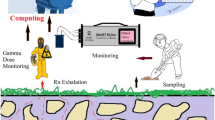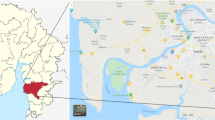Abstract
This paper describes radon mass exhalation rate (\({J}_{m })\) and thoron surface exhalation rate (\({J}_{s}\)) of 46 soil samples of district Faridabad, Southern Haryana, India. Scintillation detector based SMART RnDuo (AQTEK System, India) coupled with exhalation chamber was used. Outdoor gamma exposure rate was measured by GM counter based survey meter. \({J}_{m }\) of one sample and \({J}_{s}\) of 95% samples were found higher than world average values of 57 mBq kg−1 h−1 and 3600 Bq m−2 h−1 for \({J}_{m}\) and \({J}_{s}\) respectively reported by UNSCEAR 2000. No significant correlation was observed between radon/thoron exhalation rates with outdoor gamma exposure rate.
Access this article
We’re sorry, something doesn't seem to be working properly.
Please try refreshing the page. If that doesn't work, please contact support so we can address the problem.








Similar content being viewed by others
References
UNSCEAR. United Nation Scientific Committee on the Effect of Atomic Radiation (2002) Sources, effetcs and risks of ionizing radiation. Report to the General Assembly, United Nation, New York
Zhang X (2017) Radioactivity level of soil around a coal-fired thermal power plant of northwest China. Int J Radiat Res 15(3):321–324
Usikalu MR, Maleka PP, Malik M et al (2018) Assessment of geogenic natural radionuclide contents of soil samples collected from Ogun State, Southwestern, Nigeria. Int J Radiat Res 13(4):355–361
Nazaroff WW (1992) Radon transportation soil to air. Rev Geophys 30:137–160
Sahoo BK, Sapra BK, Gaware JJ et al (2011) A model to predict radon exhalation from walls to indoor air based on the exhalation from building material samples. Sci Total Environ 409:2635–2641
IAEA. International Atomic Energy Agency (2013) Measurement and calculation of radon releasses from NORM residues. IAEA, TRS No. 474 https://www-pub.iaea.org/MTCD/Publications/PDF/trs474_webfile.pdf
Sahoo BK, Mayya YS, Sapra BK et al (2010) Radon exhalation studies in an Indian uranium tailings pile. Radiat Meas 45:237–241
Anamika K, Mehra R, Malik P (2020) Assessment of radiological impacts of natural radionuclides and radon exhalation rate measured in the soil samples of Himalayan foothills of Uttarakhand, India. J Radioanal Nucl Chem 323:263–274
Constantin C, Botond P, Mircea M et al (2010) Measurement of radon potential from soil using special method of sampling. Acta Geophys 58(5):947–956
Gadgil AJ (1992) Models of radon entry. Radiat Prot Dosim 45:373–379
Singh P, Singh P, Bajwa BS et al (2017) Radionuclide contents and their correlation with radon–thoron exhalation in soil samples from mineralized zone of Himachal Pradesh. J Radioanal Nucl Chem 311:253–261
Singh B, Kant K, Garg M et al (2019) A comparative study of radon levels in underground and surface water samples of Faridabad district of Southern Haryana, India. J Radioanal Nucl Chem. https://doi.org/10.1007/s10967-018-6384-1
Singh B, Kant K, Garg M et al (2019) A study of seasonal variations of radon, thoron and their progeny levels in different types of dwellings in Faridabad district, Southern Haryana, India. J Radioanal Nucl Chem. https://doi.org/10.1007/s10967-019-06544-3
Tokonami S, Yang M, Yonehara H et al (2002) Simple discriminative measurement technique for radon and thoron concentrations with a single scintillation cell. Rev Sci Instrum 73:69. https://doi.org/10.1063/1.1416121
Chauhan RP, Chakarvarti SK (2002) Radon exhalation rates from soils and stones as building materials. Indian J Pure Appl Phys 40:670–673
Chauhan RP (2011) Radon exhalation rates from stone and soil samples of Aravali hills in India. Iran J Radiat Res 9(1):57–61
Kant K, Upadhyay SG, Sonkawade RG (2006) Radiological risk assessment of use of phosphate fertilizers in soil. Iran J Radiat Res 4(2):63–70
Pant P, Kandari T, Prasad M et al (2016) A comparative study of diurnal variation of radon and thoron concentrations in indoor environment. Radiat Prot Dosim 171(2):212–216
Sahoo BK, Sapra BK, Kanse SD et al (2013) A new pin-hole discriminated 222Rn/220Rn passive measurement device with single entry face. Radiat Meas 58:52–60
GSI (2012) Geology and mineral resources of Haryana. GSI Misc Pub 30 part XVIII, 2nd edn. Geological Survey of India, Kolkata
Survey meter PM 1405. Category: electronic dosimeters https://en.polimaster.com/catalog/electronic-dosimeters/survey-meter-pm1405/#tab-2
Gaware JJ, Sahoo BK, Sapra BK (2011) Development of online radon and thoron monitoring systems for occupation and general environment. BARC News Lett 318:45–51
Gaware JJ, Sahoo BK, Sapra BK (2012) Development of a portable radon monitor for multiple applications. In: 30th IARP conference on radiological protection and safety in nuclear reactors and radiation installation, Mangalore, India, p 83. (IARPNC-2012)
Gaware JJ, Sahoo BK, Sapra BK, Mayya YS (2011) Indigenous development of online radon and thoron monitors for applications in uranium mining and thorium processing facilities. Founder’s Day Special Issue BARC News Letter DAE EA, vol 30, pp 149–153. http://www.barc.gov.in/publications/nl/2011/fday2011.html
Sahoo BK, Agarwal TK, Gaware JJ et al (2014) Thoron interference in radon exhalation rate measured by solid state nuclear track detector based can technique. J Radioanal Nucl Chem 302:1417–1420
Menon SR, Sahoo BK, Balasunder S et al (2015) A comparative study between the dynamic method and passive can technique of radon exhalation measurements from samples. Appl Radiat Isot 99:172–178
Aldenkamp FJ, De Meijer RJ, Put LW (1992) An assessment of in situ radon exhalation measurements, and the relation between free and bound exhalation rates. Radiat Prot Dosim 45:449–453
Sahoo BK, Nathwani D, Eappen KP et al (2007) Estimation of radon emanation factor in Indian building materials. Radiat Meas 42:1422–1425
Prajith R, Rout RP, Kumbhar D et al (2019) Measurements of radon (222Rn) and thoron (220Rn) exhalations and their decay product concentrations at Indian Stations in Antarctica. Environ Earth Sci. https://doi.org/10.1007/s12665-018-8029-7
Kumari R, Kant K, Garg M (2016) Measurement of radium concentration and radon exhalation rates of soil samples collected from some areas of district Faridabad. ISST J Appl Phys 7(1):6–8
Kaur M, Kumar A, Kaur S et al (2018) Assessment of radon/thoron exhalation rate in the soil samples of Amritsar and Tarn Taran district of Punjab state. Radiat Prot Environ 41(4):210
Kumar A, Vij R, Sharma S et al (2018) Assessment of radionuclide concentration and exhalation studies in soil of lesser Himalayas of Jammu and Kashmir, India. Acta Geophys. https://doi.org/10.1007/s11600-018-0119-0
Kaur K, Kumar A, Mehra R et al (2018) Study of radon/thoron exhalation rate, soil-gas radon concentration and assessment of indoor radon/thoron concentration in Siwalik Himalayas of Jammu & Kashmir. Hum Ecol Risk Assess Int J. https://doi.org/10.1080/10807039.2018.1443793
Bala P, Kumar V, Mehra R (2017) Measurement of radon exhalation rate in various building materials and soil samples. J Earth Syst Sci. https://doi.org/10.1007/s12040-017-0797-z
Shivanandappa KCS, Yerol N (2018) Radon concentration in water soil and sediments of Hemavathi river environments. Indoor Built Environ. https://doi.org/10.1177/1420326X16688522
Kaliprasad CS, Narayana Y (2018) Distribution of natural radionuclides and radon concentration in the riverine environs of Cauvery South India. J Water Health 16(3):476–486
Mishra UC (1972) Natural and fallout gamma nuclides in Indian soils. In: Natural radiation environment—II, vol 1, USERDA, CONF-720805-P2, p 333
Sankaran AV, Jayaswal B, Nambi KSV (1986) U, Th and K distributions inferred from regional geology and the terrestrial radiation profiles in India. Technical report, BARC 53
Ramachandran TV, Sahoo BK (2009) Thoron (220Rn) in the indoor environment and work places. Indian J Phys 83(8):1079–1098
Sundar SB, Chitra N, Vijaylakshmi I et al (2015) Soil radioactivity measurements and estimation of radon/thoron exhalation rate in soil samples from Kalpakkam residential complex. Radiat Prot Dosim. https://doi.org/10.1093/rpd/ncv313
Karthik Kumar MB, Nagaish N, Mathews G (2018) Study on influence of soil and atmospheric parameters on radon/thoron exhalation rate in the Bangalore University, Bengaluru. Radiat Prot Environ 41(1):8–11
Mehta V, Chauhan RP, Mudahar GS (2015) Monitoring of radon, thoron, their progeny concentrations in dwellings, and radon exhalation rates of soil/sand of Rupnagar district Punjab, India. Environ Earth Sci. https://doi.org/10.1007/s12665-015-4492-6
UNSCEAR (2000) Sources and effects of ionizing radiation. Report to the general assembly with scientific annexes. United Nations Scientific Committee on the Effects of Atomic Radiation, New York
Acknowledgements
The authors are thankful to Board of Research in Nuclear Sciences ( BRNS), Department of Atomic Energy (DAE), Government of India, for extending financial assistance vide Project No.(36(4)/14/2014-BRNS/36018) dated 26/02/2016 for carrying out this work.
Author information
Authors and Affiliations
Corresponding author
Additional information
Publisher's Note
Springer Nature remains neutral with regard to jurisdictional claims in published maps and institutional affiliations.
Rights and permissions
About this article
Cite this article
Singh, B., Kant, K., Garg, M. et al. Quantification of radon/thoron exhalation rates of soil samples collected from district Faridabad of Southern Haryana, India. J Radioanal Nucl Chem 326, 831–843 (2020). https://doi.org/10.1007/s10967-020-07365-5
Received:
Published:
Issue Date:
DOI: https://doi.org/10.1007/s10967-020-07365-5




